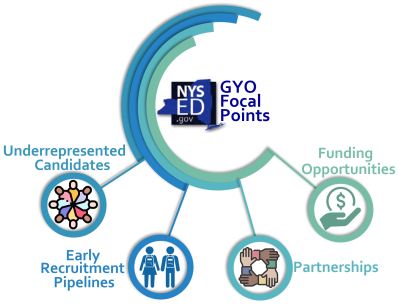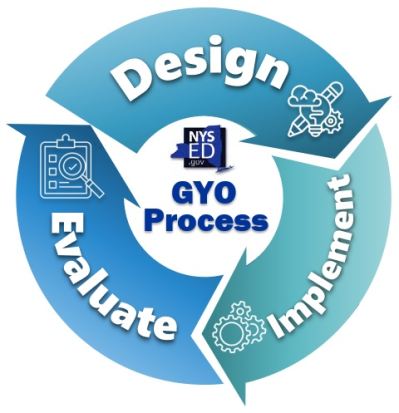Grow Your Own Initiatives
The New York State Education Department’s vision for a Sustaining Educator Pipeline includes a comprehensive system that supports the recruitment, development, and retention of high-quality, diverse educators. It encompasses strategies and programs designed to attract talented individuals to the teaching profession, provide them with effective training and professional learning, and create supportive working environments that encourage their long-term commitment to education. The Sustaining Educator Pipeline aims to ensure a continuous flow of skilled and dedicated educators, ultimately improving educational outcomes for all students. Taken as a whole, these initiatives represent a systemic approach to addressing perennial challenges in education, offering a forward-thinking solution to the critical issues in the field. The concept of Grow Your Own (GYO) programs – that is, looking from within schools and communities for the next generation of teachers – is an innovative approach that not only fosters the development of a diverse and skilled teaching workforce but also ensures the sustainable growth and enhancement of the entire educational ecosystem.
The Department has created this guidance for school districts and Boards of Cooperative Educational Services (BOCES), hereafter collectively referred to as Local Education Agencies (LEAs), to use in the development of GYO initiatives aimed at attracting community members into the field of education and providing them support on their path to certification. Understanding that the issues surrounding attracting, developing, and retaining educators vary between LEAs, our intent with this guidance is to provide an array of options for LEAs to consider and select from based on their unique needs, interests, and resources. We believe there is an accessible GYO initiative here for any LEA that would like to tap into their local community to expand and diversify their educational staff.
Our process for developing this guidance included consulting with institutions of higher education (IHEs) and the latest research on teacher development, GYO programs, and underrepresented populations in educator roles. We also engaged in conversations with LEA leadership across New York State to learn about their GYO initiatives, successes, and advice they would provide to other LEAs looking to implement GYO programs. This guidance presents promising GYO initiatives that are currently in practice and address New York’s GYO Focal Points:
Recruiting underrepresented candidates, including those who are current teaching assistants.
Creating early recruitment pipelines, beginning in secondary schools.
Establishing partnerships between LEAs, community-based organizations, and IHEs.
Identifying funding opportunities available to LEAs to attract and support candidates on their pathway into education professions.
The GYO focal points are threaded throughout each section of the guidance:
Grow Your Own Programs Overview
This section provides an overview of GYO program options for LEAs. We first present the five essential elements of GYO programs: partnerships, wide view of education (thinking beyond the classroom into support services such as special education and counseling, as well as building and district leadership positions), community recruitment, clear program pathways, and candidate support. We then describe popular early recruitment pipelines currently being implemented in numerous LEAs across New York, including Take a Look at Teaching clubs, dual credit courses, and articulation agreements. We also provide an overview of the multiple certification pathways available in New York, including alternative certification routes, which are particularly appealing to underrepresented candidates.
GYO Entry Points
This section provides LEAs with multiple entry points for creating a GYO program based on their needs and interests. We first present the cyclical process for establishing and sustaining a GYO program:
Design, Implement, and Evaluate
and then describe two tools to assist LEAs in their GYO design. The first is a Needs Assessment, which collects input from multiple stakeholders to assess a LEA’s current and projected needs. The second is a Network Inventory, which discovers potential partnership opportunities based on established connections. This section then moves into various GYO program designs, starting with early recruitment pipeline initiatives. We present multiple early recruitment initiatives for LEAs to consider if they would like to create or expand educator pipelines in their schools. We then focus on partnerships, providing several conversation starters to develop connections within and between schools, teachers’ unions, neighboring LEAs, and IHEs. For LEAs interested in taking their partnerships to the next level, we provide detailed information on offering dual credit education courses and developing articulation agreements or memorandums of understanding (MOUs) with existing or new partners. This section concludes with several research-based initiatives aimed at recruiting community members, particularly underrepresented candidates, into the education profession and the importance of cohorts and mentorship in candidate support.
Funding Opportunities
The costs associated with GYO programs fall into two categories: program operations and candidate support. This section describes modest GYO program operation costs such as stipends, printing, and transportation, as well as comprehensive wrap-around services critical to GYO candidate support such as salary, tuition, and childcare. To cover these costs, successful GYO programs take a network approach to financing, accessing multiple sources of funds, including pooling partnership funds, and creating financial contingency plans to navigate delays or loss of funds that do not place an undue burden on GYO candidates. This section lays out these financial considerations and lists multiple federal and New York State funding opportunities for GYO programs to include in their financial network.
Program Sustainability
The previous sections of the guidance focus on the Design and Implement phases of the GYO process; this section covers the Evaluate phase. To ensure the sustainability of GYO programs and the continuation of community educator pipelines, it is important for programs to regularly evaluate their progress. This section begins with evaluation modalities that can be implemented to obtain candidate and partner feedback such as surveys, focus groups, and cohort meetings. The section then concludes with a list of data to track candidate successes and struggles, including post-program education and employment. This information ensures program accountability, evaluation, and refinement rooted in collected feedback and data.
Share Your Programs and Events
When LEAs use multiple modalities to publicize their GYO programs and events, they increase their potential to recruit more underrepresented candidates, bolster early recruitment pipelines, develop new partnerships, and attract funding opportunities. LEAs may also be inspired to implement GYO initiatives they read about from other LEAs. This section provides a list of publication suggestions for LEAs to share their program and event successes, such as LEA websites and social media, and news and education publications.
Grow Your Own Highlights Across New York
Successful GYO programs in New York have been sustained due to the partnerships between LEAs, teachers’ unions, IHEs, and community organizations and their shared goal of fortifying local educator pipelines. In this section, we first present early recruitment pipeline exemplars, as well as a list of recipients of New York State United Teachers’ Take a Look at Teaching (TALAT) grant, a funding opportunity for LEAs to implement TALAT clubs. We also highlight BOCES programs that offer early recruitment pipeline opportunities for secondary level students, as well as higher education and community organization programs that recruit underrepresented candidates into the field of education. The Department celebrates these partnerships and programs by shining a light on their efforts, strategies, and successes, and presenting them to LEAs as encouraging, inspirational ideas to consider implementing in their own community.
Grow Your Own Highlights in Other States
For further inspiration, this section presents robust GYO programs across the country that exemplify the GYO Focal Points (underrepresented candidates, early recruitment pipelines, partnerships, and funding opportunities). For each program highlighted, we describe their premise and structure, as well their evolution, successes, and sustainability. This section also includes information about state-allocated funds for each program. This funding recognizes the GYO programs’ crucial work in fortifying the educator pipeline and ensures the work can be amplified and sustained.
Tools and Resources
We provide three tools referenced throughout the guidance: Needs Assessment, Network Inventory, and Memorandum of Understanding (MOU) Template. The Needs Assessment is an opportunity for all LEA and community stakeholders to provide input on the current and projected needs for educators in their LEA, as well as potential candidates in the community to meet those needs. The Network Inventory, similarly, is an opportunity for LEA staff to share potential partnership opportunities based on established connections they have at neighboring LEAs, IHEs, and community organizations. The MOU Template is a document for partners to detail their shared goals and individual responsibilities in establishing and sustaining a GYO program. Each tool is customizable to meet an LEA’s needs and interests.
Acknowledgments
As mentioned above, much of the information within this guidance was provided by New York State school districts with active GYO programs. The Department would like to take this opportunity to extend our sincere gratitude to the following districts for sharing their time, resources, experience, and advice with us so we may provide their generous knowledge with other LEAs.
Farmingdale • Kenmore Town of Tonawanda • Lansingburgh • Lewiston Porter • Lockport • Longwood • New York City • Niagara Wheatfield • North Syracuse • Ossining • Utica • White Plains • Windsor







